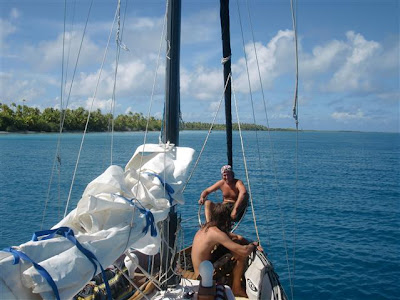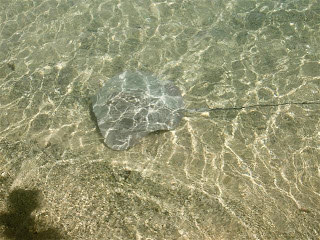It had been a pleasant short sail from
Kauehi. The winds were a bit light, but that we were used to and the
sun shone brightly on the spectacular blue water as we made way for
the north pass on Faka Rava, about twenty five nautical miles west by
northwest. We managed the timing on the pass alright, coming in about
an hour after slack tide; the current was outgoing but not more than
a couple of knots and the waves were choppy but fairly small. Dana
was at the helm and turned the engine on as we entered; we were under
full sail, but the breeze was somewhat light and I wanted to get
through quickly, so I motioned to Dana to give her some throttle. The
engine revved up as it normally would, but it sounded a bit strange
as it slipped into gear. One becomes highly sensitized to changes in
sounds on a sailboat; Ardea makes all sorts of noises and I and my
crew are intimately familiar with her tunes, so when something new
enters our ears, it is generally met with a good deal of suspicion.
The engine worked fine for a few
minutes as we made our way toward the lagoon, but soon Dana
recognized that when he increased the throttle the clutch was
slipping and the engine would rev high without driving the prop. To
his credit, I initially thought that the clutch was engaging given
our headway and attributed the revving to the current acting on the
prop and the now quite rolling motion from the chop in the pass. It
soon became clear, though, that the transmission was failing to
engage with increasing regularity.
Naturally, entering the pass at an
atoll is not an ideal time to lose the engine, but then there really
is no good time for such a thing to occur. Fortunately for us, the
wind was decent enough and we proceeded to sail up the narrow channel toward
the village of Rotoava while I got out the wrenches and the engine
workshop manual and went about trying to determine the problem. After
a while consulting the various resources on board related to our
mechanical systems, I reasoned that the most likely explanation was a
seizing oil pressure release valve. If said valve was too encumbered
with debris, it could stick open which would cause the clutch to fail
to engage. I had checked the engine oil when the problem first arose
and it had more or less drained to the port side of the engine since
we had been so heeled over; after we flattened out in the lagoon a
bit, the oil level began to rise again on the starboard side (where
the dipstick is). Supposedly the engine is designed to run at up to
thirty degrees of heel, a level I had not thought we'd breached, but
I was hoping that as we approached and the oil settled back down, the
transmission might start behaving. Nevertheless, it could not be
relied upon and I set about making a plan to anchor under sail amid
rampant coral and about ten other boats.
We dropped the main sail about a
hundred yards from where I planned to drop the hook and continued in
under jib and mizzen. A dive boat with a half dozen customers on
board followed slowly behind us, probably wondering what the hell we
thought we were doing. Some of the cruisers anchored nearby stood
watching in their cockpits; it's not often someone pulls this kind of
maneuver in the small coral-laden anchorages of the Tuamotus. It went
swimmingly, though. I tacked the boat just upwind of where the anchor
needed to drop so that we would be facing back toward the channel if
we needed to bail. Shortly after, Dana furled in the headsail, I blew
the sheet on the mizzen and Taylor dropped the hook. Later that day I
tried the engine and the transmission seemed to engage better, so I
went ahead and let myself enjoy the town and the couple of
cruiser-friends already arrived for the next few days.
 |
| The (only) road in Rotoava. |
As regular readers might suspect, we
soon made friends with some locals who were kind enough to share some
of their fruit with us. The process of agriculture is very different
there than it had been in the Marquesas, where fruit is in ridiculous
abundance. As we wandered through the acre or two plantation of our
friend, Adrian, we saw how it was done. They first dug long pits in
the ground, which was composed of sand and innumerable fragments of
coral from pebble-size to several inches long. Then they filled these
swaths with loads of composting vegetable matter. Over a period of
many years (Adrian's grandfather had begun these most productive
plots in Rotoava about thirty years ago) they gained enough nutrients
and soil structure to support bananas, papaya, pomplemousse,
eggplant, beans and a few other crops. Needless to say, the harvest
is more highly regarded here than in the Marquesas and locals
inquired as we walked back to the dinghy as to where we'd gotten all
that fruit.
 |
| A lemon shark cruises by. |
We passed a few days enjoying access to
a store and the company of friends old and new. We played soccer on
the town pitch one night, which was quite enjoyable other than having
difficulty adjusting to the rule that goals can be scored by header
only. Taylor had mentioned to one of the locals that he had a
surfboard he was willing to trade, and this generated quite a bit of
interest. Eventually he traded the board and I a spare inverter for a
number of local black pearls. We couldn't help but remark that this
was the ideal situation as both parties left from barter feeling as
though they had received the superior bargain. After we traded we
played basketball with some locals until well after dark. Though we
had once again found ourselves in a comfortable routine that we
likely could have carried on for some time, we knew we needed to get
a move on if we wanted to see the famed south pass of Faka Rava.
 |
| Soccer in Rotoava. |
The trip to the south pass was about 30
nm, though we ended up stopping about halfway to anchor for the night because
the damn transmission had started acting up again. We ended up in
quite a beautiful spot though and totally isolated, which is a good
feeling after more crowded anchorages.
 |
| At anchor in Tranny Bay, halfway to the south pass. |
The following morning we began work on
the engine. I had decided it was too risky to dismantle the oil
pressure valve on the transmission because there was an old clip ring
that I didn't think I could remove without destroying; at that time,
we were in possibly one of the worst places to be stuck in need of
parts. It was all the better though, as, before long, I had managed
to finally track down the nut on the transmission that gives access
to the oil pan. It may well have been that the valve was stuck
open, but the cause, rather than debris, was simply a lack of fluids
(the transmission oil is separate from the engine oil). Other than
cursing the now notoriously bad access to the port side of the engine
in Ardea, which had made the process of finding and fixing the
problem much more difficult than it needed to be, I was happy that it ended up being a simple
issue that was instantly corrected with the addition of some oil to the
gearbox. In high spirits and inspired by the comical name-giving from the old European navigators, we decided to name our mid-way anchorage Tranny Bay, for having fixed our transmission problems there.
 |
| Dana and Nick enjoying a beer at the small pension after a dive at the south pass. |
We pulled the hook and carried on the
rest of the way to the south pass where we anchored next to
Saltbreaker, who we hadn't seen since Hiva Oa. We promptly began to
enjoy again some of that good old jerry-jug rum and caught up with
Nick, who was alone on Saltbreaker until his brother returned from a
hiatus to the States. It wasn't until the following morning that we
indulged in the diving that gave this place its reputation. We drove
the dink to the outside of the pass on an incoming tide and hopped in
the water. The views were absolutely magnificent. The fish were
stunning in variety and abundance. Our favorites, after what became
at least four pass dives we did during our stay, were the Napolean
fish and the unicorn fish. Perhaps more awesome than those hilarious
looking creatures were the dozens of sharks swimming all around. There was
a mix of black-tip, white-tip and gray reef sharks, all of which are
rather timid, but it was still amazing to be in and among them as
they would swim around us with as much curiosity as we payed them. We
were totally mesmerized by the coral landscapes and the incredible
abundance of life in and around the pass. I'll some underwater photos later on.
 |
| An ecosystem develops beneath the boat due to the bits of food and waste that we send overboard. |
We stayed already a few days longer
than we had planned (pretty much standard) and we may have stayed
more but for a high pressure system approaching from the southwest
that was going to bring a strong northerly through, making our
current anchorage untenable. The decision to be made was whether to
change anchorages and wait out the system for another three days or
so, or put to sea and enjoy the system en route to Tahiti. I chose
the latter.
 |
| Sunset in Faka Rava. Note the random coral outcrop- these are what make the atolls so damn tricky. |
It took about an hour to get the anchor
up as it was terribly wrapped around coral heads. I watched the reef
sharks swimming around the boat curiously just before I jumped in the
water with mask and fins to observe the chain and direct Dana at the
helm and Taylor at the bow in an effort to get it off of the worst of
the tie-ups. In spite of a squall that blew through during the anchor
extravaganza, we got loose and put out through the pass. The swell
was large and the wind blew east by southeast nearing twenty knots as
we broke through the current and set a course west flying only the
jib. It was only a 240 nm passage and we were leaving the land of
scary navigation, so, in spite of the mixed and uncomfortable swell,
we sat back expecting a hasty and simple crossing. The sun set
spilling orange and pink over the outcrops of palms that seemed to
branch suddenly from the sea as the atoll fell behind the horizon. I
looked on with a bit of apprehension- this was the first time we had
put out to sea knowing the forecast was a bit nasty. But then I
thought to myself: Tahiti.

Same transmission problem happened to me leaving Ensenada, Conner, but I didn't have any ATF to add. Heeled to starboard, transmission worked, heeled port, it slipped (or vice versa??) - Will
ReplyDelete